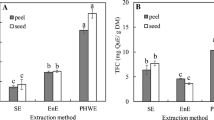Abstract
Sechum edule peel, leaves and pulp were investigated for their chemical composition (total phenol, flavonoid, carotenoid and vitamin C content), and for antioxidant activity and carbohydrate-hydrolysing enzymes (α-amylase and α-glucosidase) inhibition. In order to evaluate the incidence of cooking process on retention of healthy phytochemicals, the pulp was subjected to different treatments (grill roasting, domestic oven baking, microwave cooking, blanching and steaming). Cooking processes reduced the total phenol content (58.5 mg/g extract for fresh pulp vs 26.3 and 29.3 mg/g extract for roasted and steamed samples, respectively). Pulp was found to be the most active in 2,2′-azino-bis(3-ethylbenzothiazoline-6-sulphonic acid) (ABTS) (IC50 of 0.1 mg/mL), whereas peel showed the highest activity in 2,2-diphenyl-1-picrylhydrazyl (DPPH) test (IC50 of 0.4 mg/mL). Moreover, peel exhibited the highest inhibitory activity against α-amylase with an IC50 of 0.2 mg/mL, except for steamed cooking process, which drastically influenced the bioactivity against both enzymes.
Similar content being viewed by others
Abbreviations
- ABTS:
-
2,2′-Azino-bis(3-ethylbenzothiazoline-6-sulphonic acid)
- DIAN:
-
o-Dianisidine
- DPPH:
-
2,2-Diphenyl-1Picrylhydrazyl
- FRAP:
-
Ferric reducing ability power
- IC50 :
-
Half maximal inhibitory concentration
- SD:
-
Standard deviation
References
Newstrom LE (1990) Evidence for the origin of chayote Sechium edule (Cucurbitaceae). Econ Bot 45:410–428
Aung LH, Ball A, Kushad M (1990) Developmental and nutritional aspects of chayote (Sechium edule, Cucurbitaceae). Econ Bot 44:157–164
Flores E (1989) El chayote, Sechium edule Swartz (Cucurbitaceae). Rev Biol Trop 37:1–54
Ayankunbi MA, Keshinro OO, Egele P (1991) Effect of methods of preparation on the nutrient composition of some cassava products-Garri (eba), “Lafun” and “Fufu”. Food Chem 41:349–354
El Gharras H (2009) Polyphenols: food sources, properties and applications-a review. Int J Food Sci Technol 44:2512–2518
Turkmen N, Sari F, Velioglu YS (2005) The effect of cooking methods on total phenolics and antioxidant activity of selected green vegetables. Food Chem 93:713–718
Chohan M, Forster-Wilkins G, Opara EI (2008) Determination of the antioxidant capacity of culinary herbs subjected to various cooking and storage processes using the ABTS*+ radical cation assay. Plant Foods Hum Nutr 63:47–-52
Gao X, Ohlander M, Jeppsson N, Björk L, Trajkovski V (2000) Changes in antioxidant effects and their relationship to phytonutrients in fruits of sea buckthorn (Hippophae rhamnoides L.) during maturation. J Agric Food Chem 48:1485–1490
Loizzo MR, Tundis R, Bonesi M, Menichini F, Mastellone V, Avallone L, Menichini F (2012) Radical scavenging, antioxidant and metal chelating activities of Annona cherimola Mill. (cherimoya) peel and pulp in relation to their total phenolic and total flavonoid contents. J Food Compos Anal 25:179–184
Klein BP, Perry AK (1982) Ascorbic acid and vitamin A activity in selected vegetables from different geographical areas of the United States. J Food Sci 47:941–945
Loizzo MR, Pacetti D, Lucci P, Núñez O, Menichini F, Frega NG, Tundis R (2015) Prunus persica var. platycarpa (Tabacchiera Peach): bioactive compounds and antioxidant activity of pulp, peel and seed ethanolic extracts. Plant Foods Hum Nutr 70:331–337
Vallejo F, Tomás-Barberán F, García-Viguera C (2003) Health-promoting compounds in broccoli as influenced by refrigerated transport and retail sale period. J Agric Food Chem 51:3029–3034
Ellong EN, Billard C, Adenet S, Rochefort K (2015) Polyphenols, carotenoids, vitamin c content in tropical fruits and vegetables and impact of processing methods. Food Nutr Sci 6:299–213
Chao PY, Lin SY, Lin KH, Liu YF, Hsu JI, Yang CM, Lai JY (2014) Antioxidant activity in extracts of 27 indigenous Taiwanese vegetables. Nutrients 6:2115–2130
Nagarajaiah SB, Prakash J (2015) Chemical composition and bioactive of dehydrated peels of Benincasa hispida, Luffa acutangula, and Sechium edule. J Herbs, Spices Med Plants 21:193–202
Puntarulo S (2005) Iron, oxidative stress and human health. Mol Asp Med 26:299–312
Ordoñez AAL, Gomez JD, Vattuone MA, Isla MI (2006) Antioxidant activities of Sechium edule (Jacq.) Swartz extracts. Food Chem 97:452–458
Sulaiman SF, Ooi KL, Supriatno L (2013) Antioxidant and α-glucosidase inhibitory activities of cucurbit fruit vegetables and identification of active and major constituents from phenolic-rich extracts of Lagenaria siceraria and Sechium edule. J Agric Food Chem 61:10080–10090
Maity S, Firdous SM, Debnath R (2013) Evaluation of antidiabetic activity of ethanolic extract of Sechium edule fruits in alloxan-induced diabetic rats. World J Pharm Sci 2:3612–3621
Pinent M, Castell A, Baiges I, Montagut G, Arola L (2008) Bioactivity of flavonoids on insulin-secreting cells. Compr Rev Food Sci Food Saf 7:299–308
Ahmed OM, Moneim AA, Yazid IA, Mahmoud AM (2010) Antihyperglicemic, antihyperlipidemic and antioxidant effects and the probable mechanisms of action of Ruta graveolens infusion and rutin in nicotinamide-streptozotocininduced diabetic rats. Diabetol Croat 39:15–35
Lo Piparo E, Scheib H, Frei N, Williamson G, Grigorov M, Chou CJ (2008) Flavonoids for controlling starch digestion: structural requirements for inhibiting human alpha-amylase. J Med Chem 51:3555–3561
Acknowledgments
The authors wish to thank Dr. Anna Franca Plastina, Department of Pharmacy, Health and Nutritional Sciences, University of Calabria, I-87036 Rende (CS), Italy for the proof-read version of the manuscript.
Author information
Authors and Affiliations
Corresponding author
Ethics declarations
Conflict of Interest
The authors declare no conflict of interest. This article does not contain any studies with human or animal subjects.
Rights and permissions
About this article
Cite this article
Loizzo, M.R., Bonesi, M., Menichini, F. et al. Antioxidant and Carbohydrate-Hydrolysing Enzymes Potential of Sechium edule (Jacq.) Swartz (Cucurbitaceae) Peel, Leaves and Pulp Fresh and Processed. Plant Foods Hum Nutr 71, 381–387 (2016). https://doi.org/10.1007/s11130-016-0571-4
Published:
Issue Date:
DOI: https://doi.org/10.1007/s11130-016-0571-4




